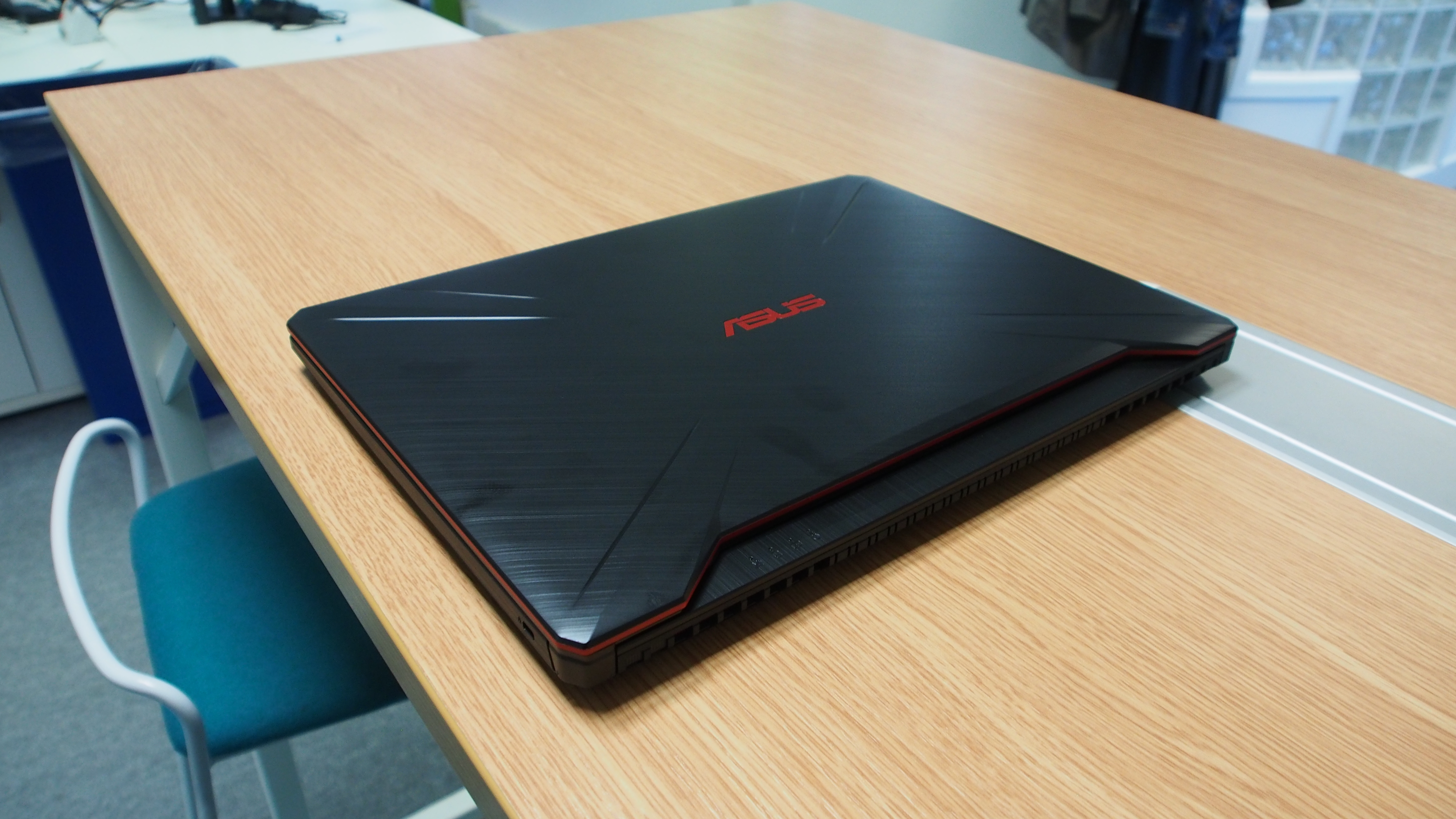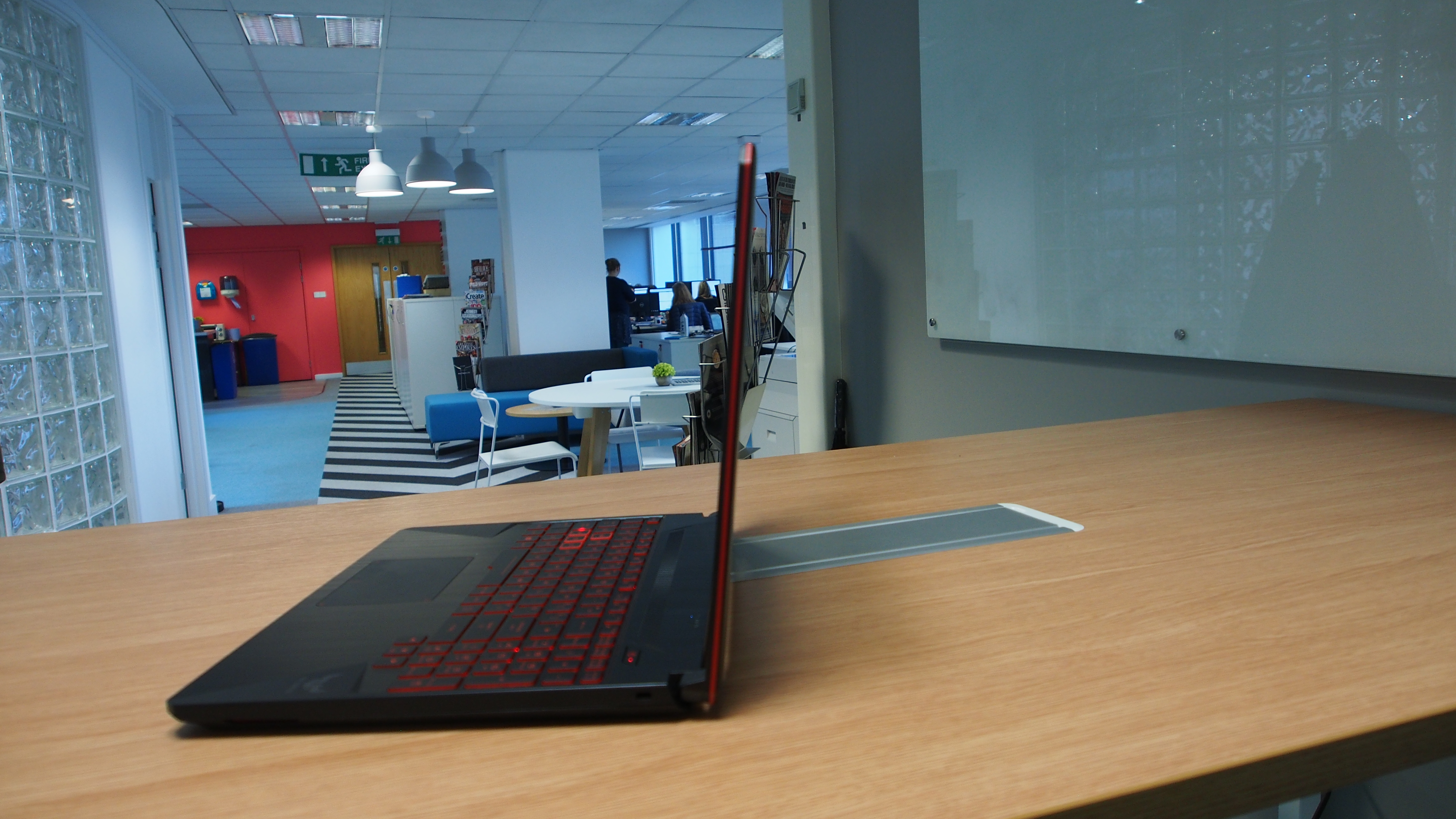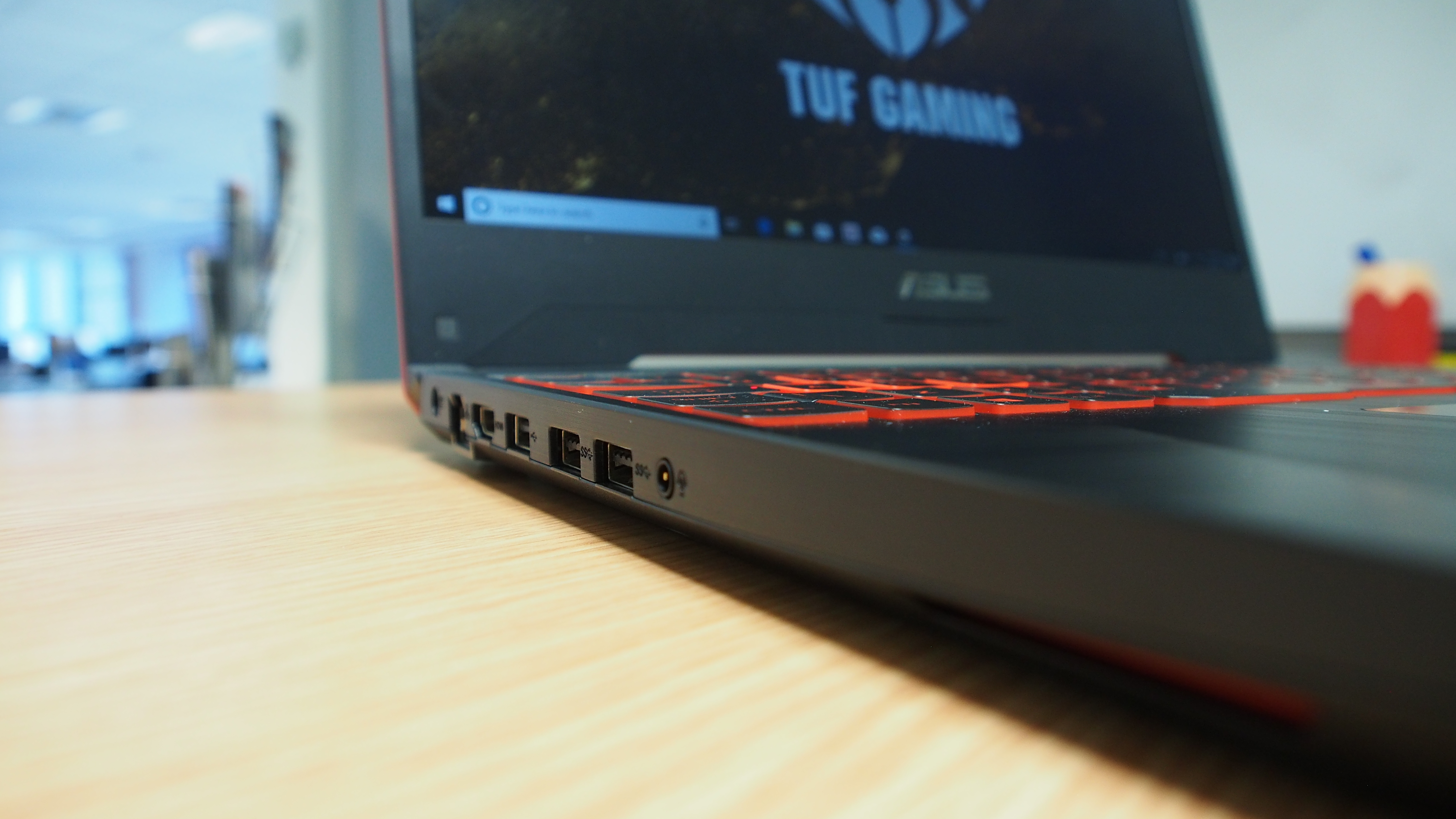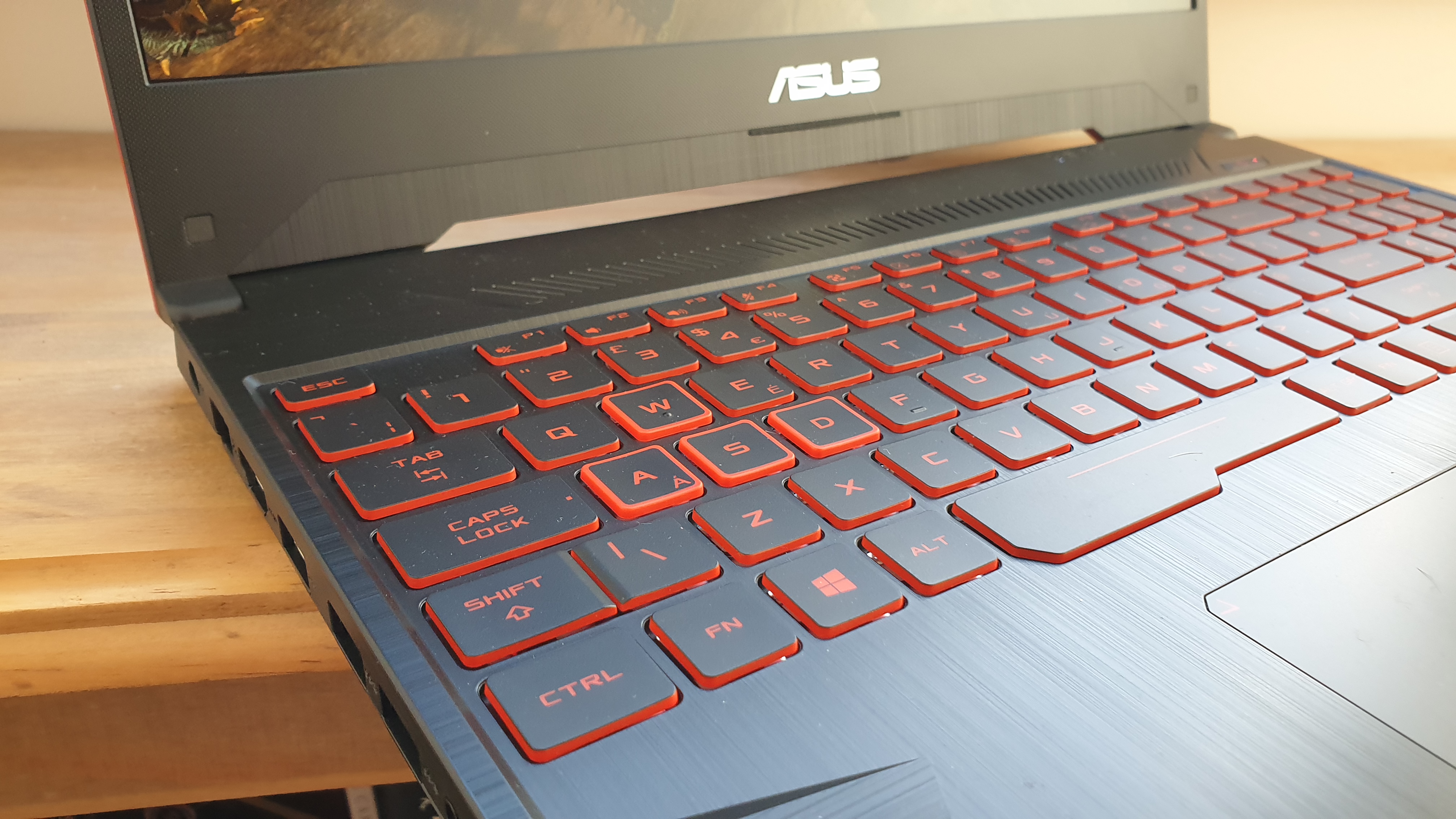TechRadar Verdict
The Asus TUF Gaming FX505DY is an affordable gaming laptop built on AMD tech. However, it struggles with modern, graphically-intensive games.
Pros
- +
Affordable price
- +
Robust build quality
- +
Thin screen bezels
Cons
- -
Underpowered performance
- -
System runs loud
- -
Poor battery life
Why you can trust TechRadar
Update: Due to some odd benchmark results and faulty LEDs behind the keyboard, we contacted Asus to supply us with another Asus TUF Gaming FX505DY to test. The new version provided slightly better benchmark results, and an improved battery life, so we have amended the review to reflect this. The performance improvements were not enough to change our overall view of the Asus TUF Gaming FX505DY, however.
The Asus TUF Gaming FX505DY is a gaming laptop that goes all-in on AMD hardware. Freshly announced at CES 2019, the Asus TUF Gaming FX505DY features AMD’s new Ryzen 5 3550H quad-core mobile processor.
It also features an AMD Radeon RX 560X graphics card, with a 15.6-inch AMD FreeSync display.
If you’re not a fan of Nvidia and Intel’s mobile offerings, which dominate the laptop gaming market, then the Asus TUF Gaming FX505DY promises to be a tempting alternative.
Can the combination of Asus’s well-deserved reputation for brilliant gaming laptops and AMD’s latest mobile gaming technology put Intel and Nvidia's hegemony into question?
Here is the Asus TUF Gaming FX505DY configuration sent to TechRadar for review:
CPU: 2.1GHz AMD Ryzen 5 3550H (quad-core, 4MB cache, up to 3.7GHz)
Graphics: AMD Radeon RX 560X (4GB HBM2)
RAM: 16GB DDR4 (2,400MHz)
Screen: 15.6-inch, Full HD (1,080 x 1,920; 120Hz) NanoEdge display
Storage: 512GB SSD (PCIe)
Ports: 2 x USB 3.1, 1 x USB 2.0, HDMI 2.0, LAN, 3.5mm headphone and mic combo jack
Connectivity: 802.11ac Wi-Fi, Bluetooth 4.2
Camera: HD (720p) webcam
Weight: 4.9 pounds (2.2kg)
Size: 14.17 x 10.3 x 1.1 inches (36 x 26.2 x 2.68cm; W x D x H)
Price and availability
The Asus TUF Gaming FX505DY costs £749.99 (around $900, AU$1,300) for the base model, and for that price you get a 15.6-inch full HD display with a refresh rate of 120Hz, an AMD Radeon RX560X graphics card and AMD Ryzen 5 3550H processor.
We’re following up with Asus to get confirmed US and Australian prices.
You can also configure the Asus TUF Gaming FX505DY with up to 32GB of RAM and up to 1TB of SSHD storage, or 512GB of PCIe SSD storage. Of course, these additional specifications will come with different price points.
The price tag is very reasonable for a gaming laptop, pitting it against budget and midrange machines, such as the Acer Nitro 5, and previous Asus TUF laptops, like the Asus TUF FX504GD.
With many gaming laptops costing over $1,000/£1,000/AU$1,800, it’s good to see Asus provide something for those of us who haven’t got that kind of budget.
As with other AMD-based laptops, it’s priced very competitively compared to gaming laptops with Intel CPUs and Nvidia graphics. If it can perform as well as its Intel/Nvidia counterparts, then the Asus TUF Gaming FX505DY offers very good value for money indeed.
If you want a bigger screen, then there’s also the Asus TUF FX705DY, which has pretty much exactly the same spec, except its 1080p screen is 17.3 inches and refresh rate is half at 60Hz.
The other differences are the larger and heavier size of the FX705DY (as to be expected), and the larger laptop comes with a bigger 64Wh battery compared to the 48Wh of the FX505DY. With the battery needing to power the larger screen, however, we’d guess that battery life will actually be pretty similar between the two models.
Price-wise, the FX705DY is only a bit more expensive at £799.99 (around $1,000, AU$1,400). Again, both US and Australian prices are to be confirmed.
Both the Asus TUF Gaming FX505DY and FX705DY will go on sale world-wide in Q1 2019.

Design
If you’re after a slim and light gaming laptop in the vein of Asus’ ROG Zephyrus line of laptops, then you’ll want to look elsewhere. At this price point, and with the ‘TUF’ moniker, you shouldn’t expect a lightweight gaming device.
However, it’s not as big and bulky as gaming laptops from a few years ago, with dimensions of 39.9 x 27.9 x 2.6cm (15.7 x 11 x 1.02 inches) and a weight of 2.2kg (4.85 pounds). It’s a sturdy feeling laptop that you’ll feel comfortable carrying around with you, while not being too heavy.
As with other devices in Asus’s TUF brand, the Asus TUF Gaming FX505DY has been put through a number of durability tests, including the military-grade MIL-STD-810G certification, to ensure that it is tough and robust.
So, it can withstand high altitudes, solar radiation (!) and perhaps most usefully, knocks and drops – within reason.
While you’ll probably not need high altitude or humidity protection, the fact that it has been tested for shock and vibration protection is good to know – especially if you’re taking this laptop out and about a lot to competitions and tournaments.
It also means that you shouldn’t have to worry about your shiny new gaming laptop getting broken. This approach puts the flimsy feel of more expensive laptops to shame.

Of course, the price you pay for this kind of protection is a more chunky laptop design that feels a bit dated when compared to (more expensive) thin and light gaming laptops. But, for people who want a solid laptop they don’t have to worry about when carrying it around, the larger design could be worth it.
Plus, the overall dimensions of the Asus TUF Gaming FX505DY have been kept down, thanks to some impressively slim bezels around the screen. Asus calls it a ‘NanoEdge Display,’ with the left and right bezels measuring just 6.5mm, with the top one not much thicker (due to inclusion of the webcam, we’d wager).
Not only do the thin bezels keep the dimensions of the laptop down while offering a decent screen size, it also gives more prominence to the display. This is one of the areas wherein the design of the Asus TUF Gaming FX505DY feels modern.
The Asus TUF Gaming FX505DY comes in two color options, Gold Steel and Red Matter. We were sent the latter, and it’s OK, to be honest, but nothing breath-taking. Gold Steel looks a bit more interesting from the images we’ve seen.
The laptop's 'WASD' keyboard keys (more on those in a bit) are wrapped in red lines, and the Asus logo on the rear of the screen is a metallic red. With Gold Steel, you get yellow keys and a gold Asus logo.

The rest of the body around the keyboard has a brushed steel look, but it’s a distinctly plastic-feeling laptop. It’s fine for the price, but if you want a gaming laptop that looks – and feels – more impressive, then you’ll probably need to look elsewhere and be prepared to pay more money.
A quick note on ports. You get a decent array of ports, most of which you’d expect on a gaming laptop at this price point. So, you have a USB 2.0 port, two USB 3.1 ports, an Ethernet port, combo audio jack and HDMI 2.0 port. These are all placed along the left-hand side of the laptop, and there’s a port for the power charger as well.
The lack of USB-C is a shame, but not too surprising in a budget laptop like this. Still, we’d have liked to have seen one to future-proof the Asus TUF Gaming FX505DY for new peripherals.

Hyperstrike keyboard
According to Asus, the TUF Gaming FX505DY’s keyboard is 'desktop-inspired', which means you should expect the kind of quality and comfort you’d get from a desktop PC keyboard.
We’re not completely convinced by that, but the keyboard isn't bad for a laptop of this price. The keys are a decent size, which makes it easy for fast typers to hit the correct letters as they hammer away, and Asus promises the keyboard is good for 20 million key presses.
The keys also have a 1.8mm key travel. This is rather shallow, so the keyboard doesn’t feel as responsive – or satisfying – to type on as a desktop keyboard. The WASD keys are also highlighted to help FPS players – though if you’re a keen player it’s unlikely you’ll really need any help finding those essential keys.
Image Credit: TechRadar
Looking to save money on an Asus device? Check out our Asus coupon codes for big savings on top tech.

Matt is TechRadar's Managing Editor for Core Tech, looking after computing and mobile technology. Having written for a number of publications such as PC Plus, PC Format, T3 and Linux Format, there's no aspect of technology that Matt isn't passionate about, especially computing and PC gaming. He’s personally reviewed and used most of the laptops in our best laptops guide - and since joining TechRadar in 2014, he's reviewed over 250 laptops and computing accessories personally.
